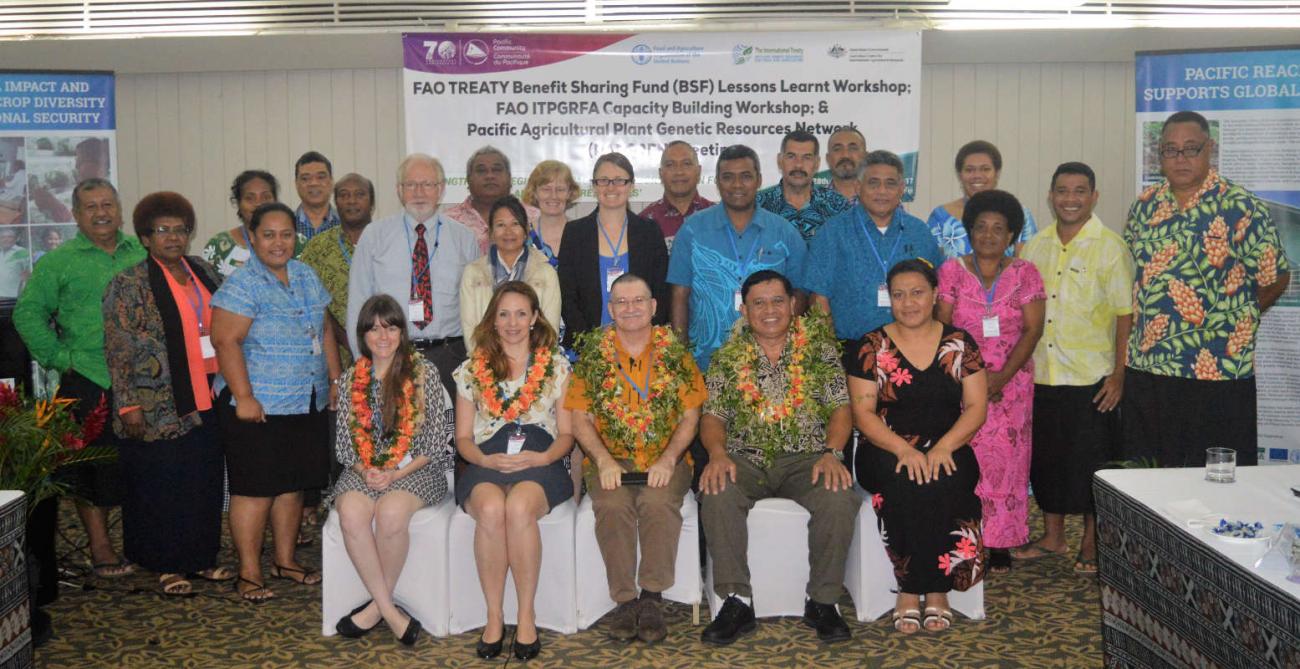The Pacific Agricultural Plant Genetic Resources Network (PAPGREN) has been formalised to strengthen its role in the Pacific in the conservation and use of plant genetic resources for food and agriculture. The network, under the auspices of the UN FAO International Treaty on Plant Genetic Resources for Food and Agriculture (ITPGRFA), is a single platform housed under the Pacific Community (SPC) to strengthen regional capacity and coordination in plant genetic resources.
The FAO Plant Treaty Secretariat, a significant SPC partner in global crop diversity conservation, conducted a review of a FAO Treaty Benefit Sharing Fund project implemented by SPC in collaboration with Treaty beneficiary countries. The project targeted the use of new crop varieties sourced from CePaCT in addition to locally selected varieties. These lessons contributed to the agenda for a ‘lessons learnt workshop’ and a ‘Treaty capacity building workshop’ jointly coordinated by SPC, the FAO Plant Treaty Secretariat and Australia’s Department of Foreign Affairs and Trade (DFAT).
Twenty-nine participants from 14 Pacific Island Countries and Territories (American Samoa, Cook Islands, Fiji, Guam, Kiribati, New Caledonia, Palau, Papua New Guinea, Samoa, Solomon Islands, Tonga, Tokelau, Tuvalu and Wallis and Futuna), resource personnel from the FAO Treaty Secretariat, DFAT, the Australian Department of Agriculture and Water Resources (DAWR), the PNG Coconut Industry Corporation (KIK), the Secretariat of the Pacific Regional Environment Programme (SPREP), Fiji National University (FNU) and SPC staff, took part in the week long meeting.
Since 2011, SPC’s Land Resources Division has been the implementing agency for the ITPGRFA in the Pacific. Nine Pacific Island countries have signed up to the Treaty (Cook Islands, Fiji, Kiribati, Palau, Samoa, Marshall Islands, Papua New Guinea, Tonga and Tuvalu). Pacific French Territories (New Caledonia, French Polynesia and Wallis and Futuna) and US territories (American Samoa, Guam and Northern Marianas) are members through France and the United States of America respectively.
During the PAPGREN meeting and associated workshops, the network reaffirmed its critical role as the regional platform for the discussion of Pacific island priorities on crop diversity with focal points from SPC member countries’ Ministries of Agriculture and non-government organisations who are represented in the membership of PAPGREN.
The meeting and consequent formalisation of PAPGREN presents an opportunity for improved coordination amongst partners on the sharing of information and best practices to support more effective plant food diversity in the Pacific region. Members agreed on the conservation of a diversity of Pacific planting materials which are critical to food security; addressing the impacts of climate change; contributing to improved nutrition; and preserving traditional knowledge.
In welcoming meeting delegates, Director of SPC’s Land Resources Division, Mr Jan Helsen acknowledged the support of key development partners, FAO and DFAT; in supporting the important work of SPC’s Centre for Pacific Crops and Trees (CePaCT) and consequently, the meeting of PAPGREN stakeholders.
“CePaCT is one of SPC’s milestone achievements over its 70 years of existence, and what’s more, it is now a flagship area of SPC. Our role, therefore, is very critical; we are key to safeguarding and generating new diversity of crops and varieties that are resilient to help our region become food and nutritionally secured.”
Mr. Helsen emphasised forging new alliances with donors, governments, the private sector, Centres of Excellence and other beneficiaries who may require improved planting materials. He also highlighted the consequent need for CePaCT to become more pro-active in scaling up new tools including use of nuclear technologies to expedite the breeding programmes for desired traits.
“Specific skills we need to develop and strengthen in-house include establishing the protocols for effective virus indexing, DNA fingerprinting, and assessing nutritional values of some of the collections.”
During the PAPGREN meeting, participants reviewed lessons learnt from an FAO Treaty Benefit Sharing Fund project implemented by SPC in collaboration with Treaty beneficiary countries. Participants heard presentations on the experience of the Cook Islands, Fiji, Kiribati, Palau and Samoa in their implementation of the treaty. The project targeted the use of new crop varieties sourced from CePaCT in addition to locally selected varieties. A highlighted outcome of the project is the development of participatory plant breeding techniques shared with national ministries of agriculture and local communities to increase access to the climate ready planting material.
“SPC is an innovative model of regional exchange of crop diversity for the benefit of agricultural systems globally. Thanks to SPC’s continuous leadership, the global collaborations that the Plant Treaty promotes directly benefit farmers, researchers, and breeders in the Pacific. I am confident that country experts will continue to participate in the Plant Treaty in the spirit of harmony among commerce, environment, and agriculture” said FAO Treaty representative, Mr. Daniel Manzella.
The PAPGREN meeting was held alongside the bi-annual meeting of the Pacific Islands Rural Advisory Services (PIRAS), the regional body tasked with capacity building in extension and training to strengthen national extension services. Forging linkages between the two regional bodies highlighted the significance of increased knowledge sharing of good practices in crop development.
Background:
The Centre for Pacific Crops and Trees (CePaCT) is the only internationally recognised genebank in the Pacific. CePaCT aims to assist Pacific Island Countries and Territories to sustainably conserve and utilize their genetic resources while facilitating access to germplasm through crop improvement activities and germplasm exchange. Through effective conservation and utilization, dynamic, sustainable agricultural systems are achieved to address food and nutrition security and contribute to the protection of the environment.
The Centre is hosted by the Pacific Community within its Land Resources Division in Narere, Fiji.
Media contacts:
Salome Tukuafu, SPC Information and Communications Management Officer, [email protected]
Logotonu Waqainabete SPC CePaCT Coordinator, [email protected], Phone: +679 3379 274
